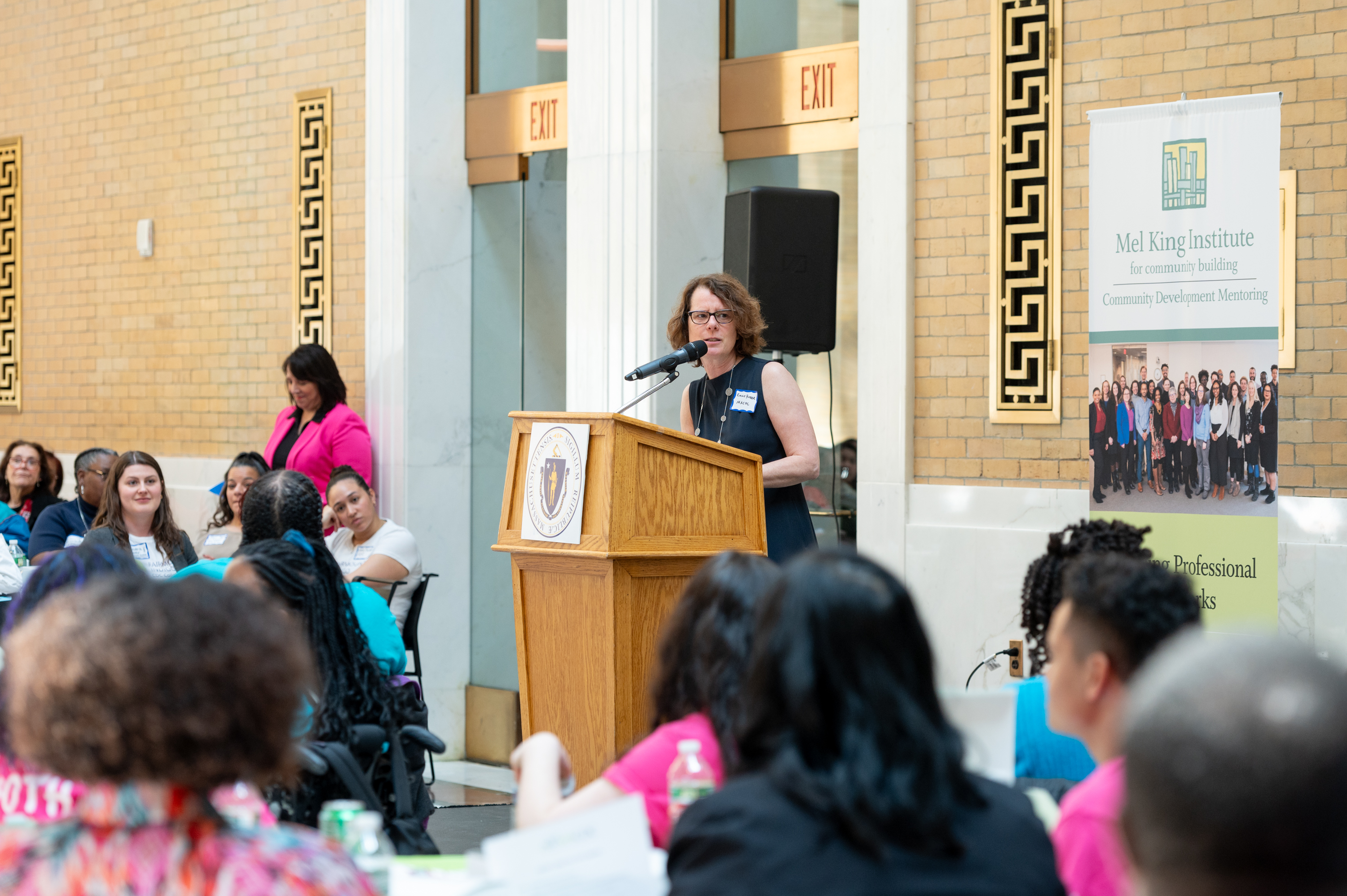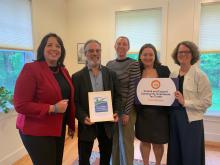Revitalize CDC in Springfield improves housing conditions by performing assessments and interventions for adults and children with asthma to safely remain in their home. (Photo credit: Revitalize CDC)
| MACDC has long supported its members in their work to improve housing quality. In recent years, MACDC worked with it's members to establish health equity work as a defining characteristic of the contemporary community development movement in Massachusetts. We are now in the beginning stages of an initiative to link these two strands of our work. We would like to engage with as many stakeholders as possible in this process, and, therefore, are publishing this series of blog posts to share out ideas and get your feedback. |
Defining the Problem
In our first blog post, we discussed how housing quality can impact health on a broad scale and how Massachusetts’ housing stock is particularly susceptible to these challenges because of its age. In the following blog post, we detail how specific housing quality and safety problems can result in negative health outcomes for individuals and communities. We also discuss how and why many of these challenges disproportionately impact vulnerable populations such as children, elderly, low-income families and people of color.
Lead
Unsafe Housing Conditions:
Over 70% of homes in Massachusetts were constructed before lead paint was banned in 1978. All homes built before 1978 are likely to contain some lead-based paint which can be inhaled or ingested1 unless steps have already been taken to make them lead-safe or remove that lead paint.
The Resulting Health and Safety Problems:
Any amount of lead in the body can hurt the brain, kidneys, and nervous system, slow down growth and development, make it hard to learn, damage hearing and speech, and cause behavior problems. These problems are particularly harmful to children who absorb lead more easily than adults and who are still growing and developing. Between 2013 and 2017, 16,961 children in Massachusetts were estimated to have blood levels above 5 micrograms per deciliter – the level at which the Center for Disease Control and Prevention says the source of lead exposure should be investigated.2
Impact on Populations at Risk:
Lead exposure is unevenly distributed across the Commonwealth with communities that face inequities in accessing quality housing being particularly susceptible.3 According to the Massachusetts Department of Public Health, Black children are nearly 2.5 times more likely to have lead poisoning than white children. Additionally, children living in low-income communities are over 3 times more likely to have elevated lead levels than children living in high income communities.4 This disproportionate impact translates to over half of children with confirmed elevated blood levels being concentrated in just 19 cities and towns in Massachusetts.5
Poor Indoor Air Quality
Unsafe Housing Conditions:
Poor indoor air quality is caused by mold, dust, second-hand smoke, poor ventilation, and leaky pipes and faucets. Outdoor air pollution, from cars, smoke, and industrial sources, can also impact indoor air quality, as can weather patterns like humidity, precipitation, and wind patterns.
The Resulting Health and Safety Problems:
Poor air quality can cause respiratory and allergy symptoms including coughing, sneezing, and difficulty breathing. Exposure to air pollution can also cause asthma or make asthma symptoms worse. Asthma is particularly pervasive in Massachusetts: about one in eleven people currently has asthma, including 10.2% of adults and 12.9% of children. Asthma that is not well-controlled interferes with daily lives. For example, almost half of children with current asthma missed at least one day of school or day care as a result of their asthma symptoms.7
Impact on Populations at Risk:
Like many other health outcomes associated with housing quality, asthma is unevenly distributed across the Commonwealth. In Massachusetts 13.8% of Black, Non-Hispanic adults in Massachusetts suffer from asthma as compared with 10.4% of white adults.8 This trend is mirrored in children where, according to a 2017 report9, Emergency Department visits were 2.5 and 3.5 times higher for Hispanic and Black non-Hispanic children as compared with white children in 2012. This same report showed that 17.1% of children living in a household with income of less than $25,000 suffered from asthma as compared with 8.1% of children living in households with an income of $75,000 or greater.
Properties in Unsafe Condition
Unsafe Housing Conditions:
In rental housing in MA, the landlord is responsible for compliance with the Massachusetts State Sanitary Code. The Code requires, among other things, that the rental unit have adequate sewage disposal, heating, and hot water. The home must also be free of hazards, ranging from pest infestation to asbestos and, for households with a child under 6 years old, lead paint. While a tenant has rights in the event a landlord is not in compliance with the Sanitary Code, enforcing these rights can be time-consuming and challenging, while in the interim the unsafe conditions persist. Owner-occupants may lack the resources to address unsafe conditions in their homes.
The Resulting Health and Safety Problems:
Renters and homeowners who live in homes that are substandard or not suitable for them can suffer health consequences, including accidents and falls and the spread of infectious disease. The risks associated with overcrowded living conditions became potentially deadly during the COVID-19 pandemic. Fires, whether stemming from unsafe (and often hidden) electrical problems or other causes, can have deadly consequences.
Impact on Populations at Risk:
The same populations that are particularly impacted by unsafe housing face the double whammy of having fewer housing choices when they determine that their current homes are unsuitable. Many elders and persons with disabilities encounter a dearth of homes with the accessible or adaptable features they require. For low-income and low-wealth households, the high cost of renting or buying limits their options. For all of these households, and households encountering discrimination, finding other safe, suitable and affordable housing may not be an option at all. Further, in the event that a family is able to relocate to safer housing, the unsafe conditions that they left persist for the next family.
Despite state and federal laws that prohibit discrimination in the sale and rental of housing, discrimination persists in MA. A study released in 2020 by the Housing Discrimination Testing Program (HDTP) at Suffolk University Law School, showed that housing providers showed Black testers about half the number of apartments they showed to white testers. The same study demonstrated that, about 40 percent of the time, the housing providers stopped communicating after testers revealed they intended to use vouchers. HDTP researchers also found that families with young children faced rampant housing discrimination.
Two Factors That Exacerbate the Impact of Substandard Housing on Resident and Community Health
Two broader problems deepen substandard housing’s impact on health, and make addressing this impact more complex and challenging:
- Neighborhood-and community-level property distress requires policy interventions that go beyond individual property strategies; and
- The already pernicious impacts of climate change render addressing housing quality, without addressing climate resilience, inadequate in order to protect resident and community health.
Neighborhood Disinvestment:
Lead paint, poor indoor air quality, and unsafe housing conditions each affect community and individual health in distinct ways. As noted previously, they each disproportionately impact particular populations. Geography also plays an important role.
Many lower-income neighborhoods in Massachusetts—most notably, but not solely, in the state’s Gateway Cities and some rural communities —struggle with the challenges of weak real estate markets, where low rents and declining values, caused in significant part by decades of discriminatory housing policies, make it difficult to maintain an aging housing stock. According to a 2018 study by the Brookings Institution, “Homes of similar quality in neighborhoods with similar amenities are worth 23 percent less in majority Black neighborhoods, compared to those with very few or no Black residents.” As a result, all of the housing quality and safety problems described above can exist, and persist, on a neighborhood or community-wide scale.
In these neighborhoods, as the cost of maintenance rises, home values can steadily decline to the point where it can stop making economic sense to invest in these structures for the long term. Where this happens, one sees absentee owners buying cheap and collecting as much rent as they can before rot wins out and the building is no longer habitable. Often the result is a dilapidated problem property sitting idle, sapping value from surrounding homes and devaluing the equity that nearby homeowners were counting on to provide financial security and a nest egg for retirement.10 These community-wide impacts call for community-level (or even regional) responses.
Climate Change:
Climate change impacts many aspects of our lives. Efforts to combat climate change, and its impact, are underway in Massachusetts, including passage of legislation to dramatically reduce climate emissions. Nonetheless, the harmful impacts of a warming climate are already being felt, in homes and neighborhoods across the Commonwealth.
The Massachusetts Executive Office of Health and Human Services (EOHHS), in its Massachusetts Environmental Public Health tracking, identifies the most serious climate-related health hazards as those resulting from:
- Increasing numbers of very hot (>90°F) summer days
- Increasing precipitation leading to flooding
- Increasing storm-related inland and coastal flooding
- Rising sea levels
According to EOHHS, climate change is expected to increase the number of days over 90°F each year, which may increase hospitalizations for heat-related illnesses. People who work outdoors, live in urban areas with limited greenspace, or lack air-conditioning are more likely to experience heat illness during extreme heat events. The U.S. Environmental Protection Agency has determined that “heat islands” (urban areas where structures are highly concentrated and greenery is limited) were responsible for daytime temperatures in urban neighborhoods rising as much as 7 degrees higher than those in outlying areas. The EPA found that the worst temperature differences are in more humid cities along the East Coast.
There are a wide variety of other ways that climate change can negatively impact human health. Air pollution events, sea-level rise, flooding, and severe weather that can result in both acute and chronic health impacts, including mental health. People who live near rivers or coastlines that experience flooding may come in contact with contaminated flood waters or experience respiratory impacts from mold growth in water-damaged homes or buildings.
Conclusion:
While housing quality and safety challenges pose a threat to community and individual health, and an even more serious threat to particular populations, there are a number of interventions that are designed to address these problems. In our next blog post, we will introduce you to these interventions and begin to identify where there are gaps.
We welcome your thoughts and reactions and would encourage you to share them with us. Elana Brochin can be reached at elanab@macdc.org; Don Bianchi at donb@macdc.org.
--
1 - https://matracking.ehs.state.ma.us/Inspections/lead-inspection.html
2 - http://www.mass.gov/guides/phit-data-childhood-lead-poisoning https://www.mass.gov/guides/phit-data-childhood-lead-poisoning
3 - https://www.ncbi.nlm.nih.gov/pmc/articles/PMC3222490/; https://www.healthypeople.gov/2020/topics-objectives/topic/social-determinants-health/interventions-resources/quality-of-housing
4 - https://www.mass.gov/doc/childhood-lead-exposure-impact-at-a-glance/download
5 - High-risk communities are defined as those with a 5-year incidence rate of children who have a confirmed concentration of ≥ 10 micrograms of lead per deciliter cases that is above the state 5-year incidence rate after adjusting for low to moderate income and old housing stock (built pre-1978)
6 - www.mass.gov/service-details/statistics-about-asthma#:~:text=About%20one%20out%20of%20every,United%20States%20and%20in%20Massachusetts.
7 - https://www.mass.gov/service-details/statistics-about-asthma
8 - https://www.mass.gov/service-details/statistics-about-asthma#:~:text=The%20prevalence%20of%20asthma%20is%20high%20in%20Massachusetts&text=The%20prevalence%20of%20current%20asthma,ethnicity%20subgroups%20in%2020152.
9 - https://www.mass.gov/doc/pediatric-asthma-data-bulletin-0/download
10 - Ben Forman and Alan Mallach, “Building Communities of Promise and Possibility: State and Local Blueprints for Comprehensive Neighborhood Stabilization”, January 2019









